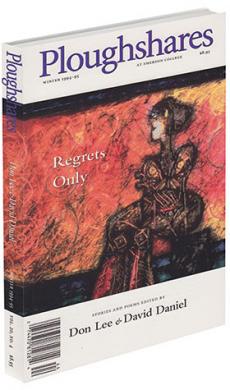rev. of Coconuts for the Saint by Debra Spark
Coconuts for the Saint
A novel by Debra Spark. Faber and Faber, $22.95 cloth. Reviewed by Ann Harleman.
Bright, wistful, and brash, Debra Spark’s first novel,
Coconuts for the Saint, snares the reader instantly. On the surface it is a mystery story: Who is Sandrofo Cordero Lucero, and what is he hiding? Beneath lies another mystery,
the mystery, the one we all live out. “This is the world,” says one of the novel’s several narrators, “the one we’re so desperate not to leave. Our attachment seemed beautiful, but an endless puzzle. Why? Why do we want to stay here?”
The question of Sandrofo’s identity is first raised by Maria Elena, the woman to whom he has proposed marriage. Sensing that he is not what he claims to be, and unable to make him reveal himself, she turns to his three teenaged daughters from his previous marriage for help. Melone, Beatriz, and Tata — identical triplets with very different views on life — take turns, along with Maria Elena, in narrating the life-changing events that Maria Elena’s quest sets in motion.
The deeper mystery, the mystery of our attachment to the world and to each other, is one which all of these characters, in their different ways, pursue. The novel’s prologue shows Sandrofo bringing his five-year-old daughters from New York to Puerto Rico. It is a kind of exile: the girls’ mother, who died in childbirth, grew up in San Juan, but neither they nor their father have ever been there before. They reopen a bakery owned by the dead woman’s family and begin to weave themselves into the life of the town. Of course belonging cannot be constructed, but father and daughters seem — until the advent of Maria Elena — to have achieved a satisfactory illusion.
As for the world’s worthiness of such efforts, Spark’s language greets us from the first page with lavish gifts for the ear and eye — indeed, for all the senses. Her maximalist prose seems made of color and light, like Puerto Rico itself. It creates “a world too leafy to think of baldness,” whose inhabitants enjoy pastries filled with guava jelly, chocolate sandwiches for breakfast, shortbread with hazelnut cream. The inhabitants themselves are beautifully revealed in the gestures they make. We see Rayovac, Melone’s aspiring lover, “kneeling in a bag of flour and scooping his hands up under her apron, her flower print dress”; Beatriz swimming naked in the rain, her nipples “shriveled and tightened like old fruit”; the girls’ grandmother scattering bread crumbs on her daughter-in-law’s grave so that birds will come. In this heightened atmosphere, the gathering desires of Spark’s characters envelop us like a gorgeous fever.
Not only the physical world but the world of the heart, as well, is bared and burnished by Spark’s prose. The novel’s structure, with its self-contained, story-like chapters and alternating narrators — though occasionally creating a centrifugal effect that undermines the plot — allows its characters to reveal themselves and to comment wryly on each other and on the novel’s themes. Maria Elena’s outrageous observations on love and sex, Tata’s view of sisterhood, Sandrofo’s version of fathering, Beatriz’s wintry openness to grief — these are all great pleasures. Would we ever have thought of punctilious behavior as “emotional duct tape,” or of lying as an attempt to “unravel the sweater of fate”?
The novel picks up speed in its last third; dramatic events and revelations, although they occur a bit too precipitously, nonetheless bring the plot to a satisfying resolution. The mystery of Sandrofo Cordero Lucero, whose alias includes the words for “heart” and “light,” is solved; the mystery of our beautiful attachment to the world, happily deepened.
Ann Harleman’s collection of short stories, Happiness,
won the 1993 University of Iowa John Simmons Award. She teaches fiction writing at the Rhode Island School of Design.


